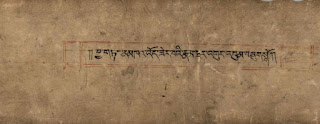Tibetan Text Titles - Part 1
When looking at or exploring Tibetan texts usually you end up first translating the title. Fortunately this title is the first thing in a major text so we start from the top. It might even be as a single front page with just the title itself. As for the author, you need to go all the way to the end of the text to find out who wrote the text, or who translated it, why to whom it was written to, where it was written (location), or sometimes you even get a time when the text was written (where the time is often very cryptic, or you need to consult astrological calendars).
Going back to the title, the format in most cases look something like this:
བྱང་ཆུབ་སེམས་དཔའི་སྤྱོད་པ་ལ་འཇུག་པ་ཞེས་བྱ་བ་བཞུགས་སོ།།
At the end we encounter བཞུགས་སོ།། bzhugs so. This means 'is herein contained' and the rest of the title follows upfront. The modern way of translating this is just to ignore it and not put it into the final translation. The rest here is then བྱང་ཆུབ་སེམས་དཔའི་ byang chub sems dpa'i (bodhisattva + sixth (genitive case), སྤྱོད་པ་ལ་ skyod pa la behavior + fourth case ལ་ particle (dative), usually rough translation of that particle is to . འཇུག་པ་ 'jug pa is engage and ཞེས་བྱ་བ་ shes bya ba is thus/so called, known as, named. So it's not so hard to see that this is Shantideva's (ཞི་བ་ལྷ) famous Bodhisattvacaryāvatāra text.
This title is interesting as we could see the following English translations that I found within a five minute Internet search: The Way of The Bodhisattva, Entering the Conduct of the Bodhisattvas, A Guide to the Bodhisattva Way of Life, Entering the Path of Enlightenment, Guide to Bodhisattva Practice. It might be that the most common one is Guide to the Bodhisattva Way of Life. But as you saw from the actual Tibetan words, you could form various other translations, either very precise or then more interpreted.
Many texts then have a shortened name used for other texts when commenting or inserting quotations (easier to carve short titles into wood than the full long title), when debating, when teaching and so on. This text's short title is སྤྱོད་འཇུག་ and you could read more about similar shortened titles in this blog post. But the main point is that the text itself always has the full title that could be very, very long in some cases. You will see that some texts have both a short description or key words about the contents as well as a more flowery name, kind of like the catch-name or 'album title' which then will become the nick-name or the more known title name amongst the scholars, tradition and practitioners.
For the next examples of text titles we will use the nicely put together list of all currently known texts written by the all the Karmapas by the ITAS Research Library. It's worth saving this list as you could then use it in translating other titles and too find possible translations for the types of texts (as this list is quite comprehensive).
First is a very common title in the beginning of larger bodies of work, གསུང་འབུམ་ gsung 'bum, collected works, as in:
རྗེ་དུས་གསུམ་མཁྱེན་པའི་གསུང་འབུམ་དཀར་ཆག Catalogue of the Collected Works of Master Düsum Khyenpa. You find the catalogue, or དཀར་ཆག dkar chag in the beginning of the collection, it is indeed the index to the rest of the collected material. གསུང་འབུམ་ is an interesting word in itself as གསུང་ is the honorific form of speech, exalted speech, and འབུམ་ is hundred thousand!
Next type is རྣམ་ཐར་ rnam thar hagiography or spiritual autobiography, as in:
ཉིད་ཀྱི་རྣམ་ཐར་གདུག་པ་ཚར་གཅོད་གཟི་བརྗིད་འོད་འབར་ - Spiritual Autobiography: Blazing Brilliant Light Vanquishing the Malevolent Ones. This is a good example of this flowery way of writing titles as well as the fact that you need to read between the lines; as this གསུམ་འབུམ་ is in the section of the 1st Karmapa, so it is one of the 1st Karmapa spiritual autobiographies. Personally I do not like the word hagiography, it sounds like an old stuffy academic term and has annotations of 'over-the-top' presentations. Not that these spiritual autobiographies -- especially the inner one -- have sections where you just have to go with flow. As you could see from the list of རྣམ་ཐར་ in this list, there are many and many in such collected works.
The beginning of གསུང་འབུམ་ also have many supplication prayers (usually to various lineage holders), གསོལ་འདེབས་ gsol 'debs as in:
བཀའ་བཞི་བརྒྱུད་པའི་གསོལ་འདེབས་ - Supplication to the Lineages of the Four Oral Transmissions.
We will continue in a forthcoming post or posts with more text titles as this seems to be a huge topic to cover in a single entry.

